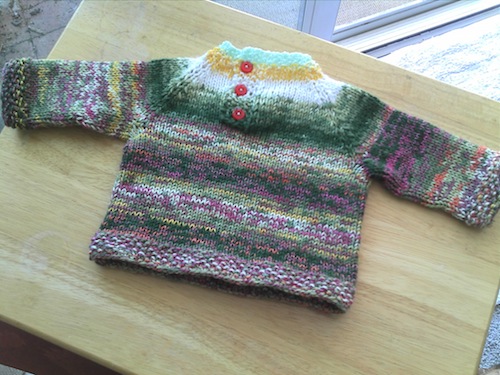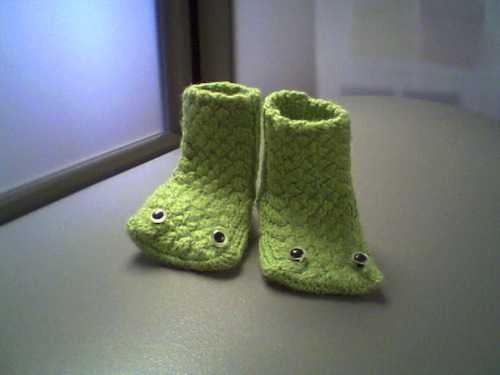 Photo: Anna Broadway
Photo: Anna Broadway
It’s funny now to think there once was a time when I thought I would mostly knit for myself. That was before the still-unending baby boom that — to date — has prompted the construction of tiny handmade garments for more than 60 children. But the baby knits began long after my grandma first taught me to knit as a girl of eight, for that preceded many years when I thought knitting to be largely impractical. My change of mind started ten years ago, one crisp autumn night in Manhattan.
I’d moved to New York the August after grad school, without savings or a job offer but with a roommate’s verbal promise and a vague notion life in that city would help me become a writer. I soon realized temp work presented my best hope for income while I looked for something long-term. By the time I started a short-term admin assignment at an ad agency on Sixth Avenue, the winds wafting through the streets of Manhattan were hinting that fall would be far colder than anything I’d experienced during the previous 12 years in Arizona. Not since my childhood in Washington had there been such a dramatic change of seasons in store! It was more than a little exciting.
As each day’s mercury proved weaker than the last, the weather presented an unexpected reality: I would need warmer clothes for winter than I presently owned. Since I had not yet earned enough for even a bed to sleep on (I’d shipped only absolute essentials to New York), the hats, gloves, and scarves with which one started the seasonal wardrobe transition presented a small financial problem. Then, just when I’d started pondering which credit card I dared charge the needed accessories to, or if I could find something decent at the thrift store in my neighborhood, I saw a Craigslist post by a girl looking for a knitting instructor.
Though some Manhattan knitting classes cost $40 an hour or more, I offered to teach her the basics for free. When we met for an after-work coffee one night, she told me that she wanted to make herself a scarf. Once we finished our drinks, we wandered along the darkened sidewalks outside, pausing now and then to carefully size up the winter-wear displays in the lighted windows of Bloomingdale’s and other stores.
I was used to taking in high-end stores more as landmarks than enticements. And, while I had recognized that the scarves sold in stores of all price ranges were usually knit, I had never really looked at them with a knitter’s eye. To my surprise, the bulk of the scarves — even in the most elegant windows — were constructed very simply, using elementary stitch combinations and ribs.
It was a revelation: With my own hands and a little patience, I could make some of the very things I’d been planning to buy — and with just as fine or a finer result. Later on would come the challenge of translating what I saw in my mind’s eye into something that could keep my neck and hands warm. For now I reveled in the discovery of this power to create.
Though I later gave the girl one or two lessons, and lent her the very pair of knitting needles my grandma had started me on so long ago, that evening look at the shop-window scarves probably had far more impact on me than my would-be pupil. I never got the needles back, but I think I half expected that when I gave them to her, as if they were a baton that had to be handed to the next knitter after me in the line of teachers and students passing through my grandmother to me and then to that girl.
I’d never really considered this lineage until that brief connection with the would-be knitter. Although I’d first picked up the needles almost twenty years before, I had not gotten very far with knitting aside from the pair of red slipper socks that were my first project and a sad little scarf made on disastrously thread-like navy yarn that prolonged the torture of its humiliating construction. As soon as I could cast off the last stitch of that second project, I did, and promptly put away both scarf and needles for several years. In the interim, I became an avid crocheter, making booties for friends’ babies, endless eyesight-threatening doilies, a collar and pastel afghan for myself, and several small coasters that were for a while my stock gift to relatives. I briefly attempted tatting and the sewing that was my mother’s passion, but other than a huge and hideous gray-and-purple sweater with a snowflake-patterned yoke that I dubbed my “undergraduate knitting project” and several years later unraveled, crocheting seemed the craft for me.
 Photo: Anna Broadway
Photo: Anna Broadway
Then came that fateful Craigslist post and the knitting meet-up. Suddenly knitting was practical — and for all the reasons it hadn’t been in Arizona. After I gave the girl her first actual lesson one day, I opened the cheerful, quilted red floral-print needle case made by my mother or hers and given to me on some long-since-forgotten occasion. Pairs of metal needles were tucked in the triple row of slim pockets inside.
As I fingered the tiny, sharp hooks and the grooved ends of the knitting needles, engraved with their various sizes, my mind skipped back and forth between memories of long-ago lessons and projects and the scarves I’d seen in the windows. So many possibilities! I couldn’t remember when or how I’d come by most of the needles I owned — probably they were extras given me by Grandma — but the motley assortment of sizes was enough to make some of the winter wear I needed. All it would take was a little yarn.
A few days later, an Internet search for yarn shops in Manhattan turned up several possibilities. It would be some time before I learned where one could find the cheaper, basic brands that were the staple of Walmarts and Arizona craft stores — not to mention most of Grandma’s and my previous projects — but what I found at the first Midtown shop I went to was sufficient to start my scarf-making.
The store wasn’t far from my current temp assignment, so one day I spent my lunch break walking through streets shadowed by the endless tall buildings, like a small child trying to keep up with long-legged elders. After a few blocks, I came to a posh-looking building with a foyer that featured a pianist, a fountain, and an open-air coffee stand, all enclosed in soaring windows that let in several floors’ worth of sun to gild the steam from the tea cups and espresso machine. Past mahogany-trimmed shops for ties and stationery that probably never went on sale and even then wouldn’t have been priced within my budget, I found my first Manhattan yarn shop.
The space could have held a handful of the cubes back at my temp assignment, but this hadn’t daunted the owners. The walls were lined with a warren of cubbyholes stuffed with all manner of opulent colors and fibers, most of which I’d never clapped eyes or hands on before. The sorts of fibers that I was learning were fairly commonplace to Manhattan denizens had been unheard-of and almost unpronounceable to my family and I. And yet I knew at one glance that this store sold far more than cotton or acrylic. Small squares that proved to be sample swatches knitted in the various yarns (not something the staff at Joann’s or Hancock Fabrics had ever troubled to make), hung from so many of the cubby-holes that, if you squinted, you could almost see the tall, laundry-lined windows of the chock-a-block apartment buildings in Singapore, where my parents had moved when I graduated from high school. And the shop really did have clothes hanging here and there, though I didn’t spy any underwear or towels among them.
I could have stayed there long past closing time, but I had to pay close attention to the clock as my lunch break would end soon. After careful deliberation and calculations, I picked the yarns for my first two scarves: one knitted in a beautiful green that a friend later said looked like I killed a peacock, and one crocheted in a vibrant purple through which I wove strips of ribbon from a small fabric store in my neighborhood.
At $30 apiece for the yarn, the scarves weren’t cheap to make, but they turned out so well that when the women at my temp jobs saw them, and learned that I had made them, I got several orders for handmade scarves the ladies wanted for Christmas presents. I couldn’t charge much more than my cost to make the scarves, but the unexpected income helped allay my guilt at the cost of the yarn for my own accessories.
I was still wrestling with the challenge of turning a profit on scarves when I came across another Craigslist knitting post. Intriguingly, the author was a woman seeking help making scarves. Curious how she covered her costs, outsourced labor and all, while still making a profit, I replied and soon had more paid knitting.
It turned out the woman used far cheaper yarns than I — one big, $5 skein of a pretty, variegated acrylic yarn was enough for one scarf — and knit the pieces on needles so thick (let’s just say they didn’t call them “broomstick needles” for nothing) one scarf could be finished in roughly 45 minutes. Since this was about the length of my daily train commute to and from Astoria, I didn’t mind that she charged only $10 a scarf and thus barely minimum wage. How many people could say they earned $10 or $20 on their daily commute?
No one pays me for the garments I knit now while commuting, but the needles have become such a part of me that I am almost lost without them to get me through a long Costco line or an airplane flight. I’ve knit while reading and watching movies, even a couple times while walking to a store. Just as breathing enables one to sing, inhale the scents of lilac and coffee, blow out birthday candles, swim and speak, so knitting threads one to life in an elaborate, ever-changing cat’s cradle. It’s probably the best gift Grandma’s ever given me.
Anna Broadway is a writer, web editor, music fiend, and knitter living near San Francisco. The author of Sexless in the City: A Memoir of Reluctant Chastity, she also writes for the Her.meneutics blog and Paste. In a previous life, she was featured in Rolling Stone, The Village Voice, and the San Francisco Chronicle, but these days she tools around on her folding bike and, of course, knits. You can find her on Twitter: @annabroadway.















